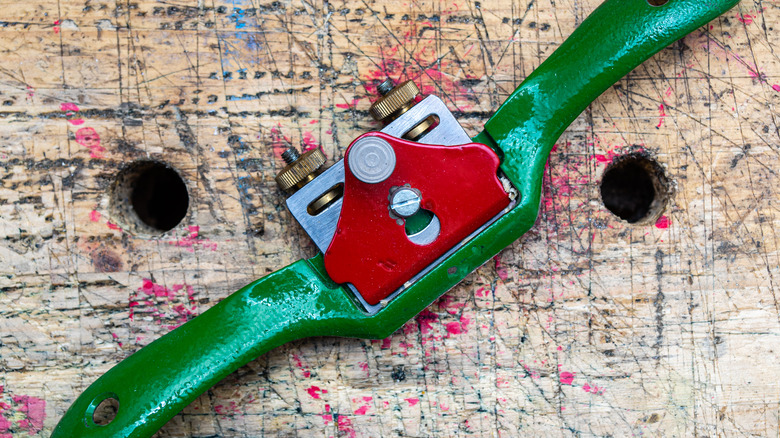The Key To Sharpening Your Spokeshave Iron For Smooth Cuts
So your spokeshave isn't shaving spokes like it used to. Or, more likely, you're not getting nice, even, curled shavings from the edges of hardwood boards like you did before working with all that Ipe or hickory. Keeping your tools sharp is one of the woodworking safety precautions you should be taking for home projects, and it helps you to do better work too. A spokeshave is simply a specialized type of plane (though you'll occasionally see them described as "routers," maybe because of their similarity to router planes). The most common spokeshave, the Stanley 151 flat-bottomed spokeshave, has a removable blade that can be sharpened like any other plane's blade. Since you only need to worry about sharpening the bevel side, it's a bit easier than a standard plane blade. But the 151 has a blade that doesn't fit into most standard sharpening jigs, so getting the right bevel angle can be a challenge. The key is to use the wrong tool for the job — in this case, locking pliers.
Of course, if you have the experience and finger strength of a master woodworker like Paul Sellers, maybe you can sharpen spokeshave blades by hand in the traditional way. But for us mere mortals, it's very difficult to hold the blade at the correct sharpening angle and with the force necessary to the task. Woodworker and YouTuber James Wright (@WoodByWrightHowTo) seems to have found the solution, or at least a shortcut to getting the angle right.
How to sharpen your spokeshave
Wright's secret is to grip the blade with locking pliers (popularly known by the brand name Vise Grips) and rest the fixed top jaw of the pliers against your sharpening stone to help you maintain the desired angle. Usually that's around 30 degrees, but Sellers says any angle between 25 and 30 degrees will work. With a little practice, you can treat the pliers like a sharpening guide. Just take care to apply even pressure, and accept the fact that you'll wear a minor flat spot on the top jaw of your pliers.
Beyond that, the process is just like hand-sharpening a spokeshave or plane blade, and much like the easy chisel sharpening method every woodworker needs. Lubricate your stones with water and sharpen as usual, mixing straight and circular strokes until you can feel a burr develop on the back edge of the spokeshave blade. Sellers says this will take 50-100 strokes, more if the blade has been abused. Polish the steel up through a 1200-grit stone, then an optional round with stropping, perhaps 30 to 40 strokes. Another alternative is to use a shop-made sharpening jig. Sellers himself has built one, as have other woodworkers. The key to the various designs is to give your blade support to keep it level and to help ensure you're sharpening at the right angle. And once you're done, you'll be ready to make some wagon wheel spokes... or at least fix the broken spoke in your mason-jar-and-wagon-wheel rustic-chic chandelier.
